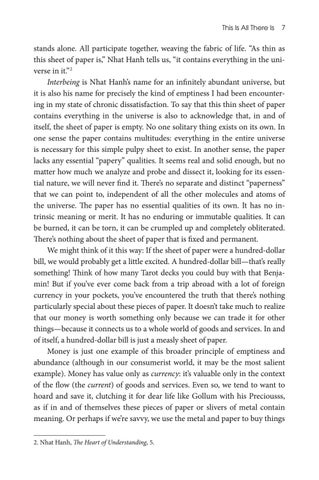This Is All There Is
7
stands alone. All participate together, weaving the fabric of life. “As thin as this sheet of paper is,” Nhat Hanh tells us, “it contains everything in the universe in it.” 2 Interbeing is Nhat Hanh’s name for an infinitely abundant universe, but it is also his name for precisely the kind of emptiness I had been encountering in my state of chronic dissatisfaction. To say that this thin sheet of paper contains everything in the universe is also to acknowledge that, in and of itself, the sheet of paper is empty. No one solitary thing exists on its own. In one sense the paper contains multitudes: everything in the entire universe is necessary for this simple pulpy sheet to exist. In another sense, the paper lacks any essential “papery” qualities. It seems real and solid enough, but no matter how much we analyze and probe and dissect it, looking for its essential nature, we will never find it. There’s no separate and distinct “paperness” that we can point to, independent of all the other molecules and atoms of the universe. The paper has no essential qualities of its own. It has no intrinsic meaning or merit. It has no enduring or immutable qualities. It can be burned, it can be torn, it can be crumpled up and completely obliterated. There’s nothing about the sheet of paper that is fixed and permanent. We might think of it this way: If the sheet of paper were a hundred-dollar bill, we would probably get a little excited. A hundred-dollar bill—that’s really something! Think of how many Tarot decks you could buy with that Benjamin! But if you’ve ever come back from a trip abroad with a lot of foreign currency in your pockets, you’ve encountered the truth that there’s nothing particularly special about these pieces of paper. It doesn’t take much to realize that our money is worth something only because we can trade it for other things—because it connects us to a whole world of goods and services. In and of itself, a hundred-dollar bill is just a measly sheet of paper. Money is just one example of this broader principle of emptiness and abundance (although in our consumerist world, it may be the most salient example). Money has value only as currency: it’s valuable only in the context of the flow (the current) of goods and services. Even so, we tend to want to hoard and save it, clutching it for dear life like Gollum with his Preciousss, as if in and of themselves these pieces of paper or slivers of metal contain meaning. Or perhaps if we’re savvy, we use the metal and paper to buy things 2. Nhat Hanh, The Heart of Understanding, 5.
